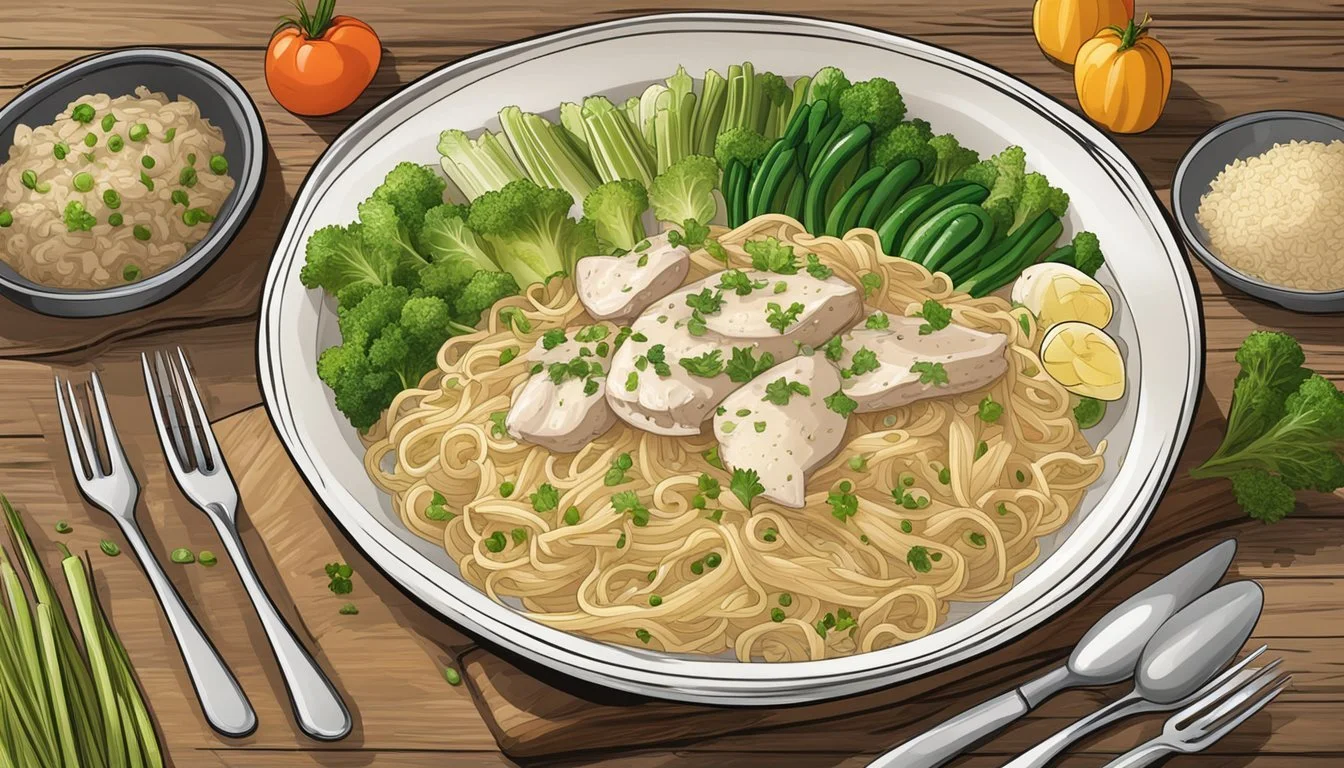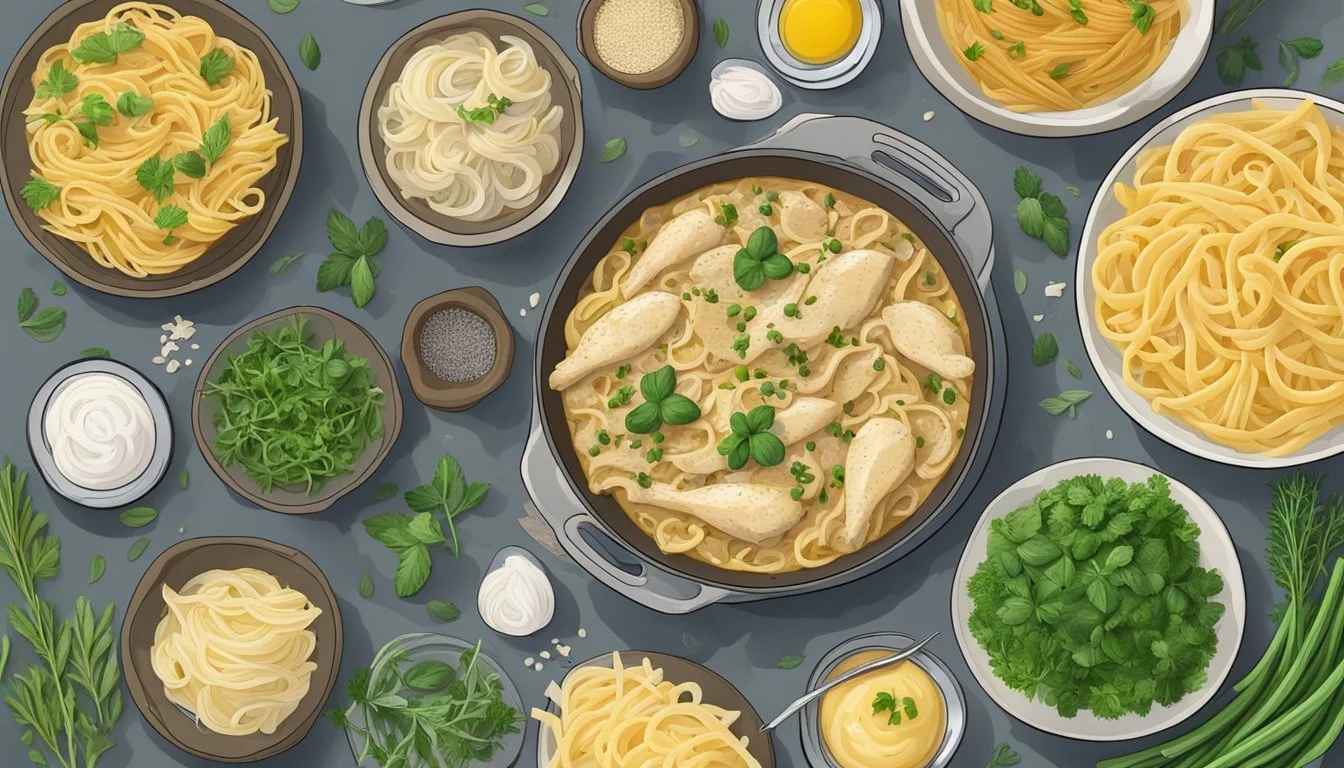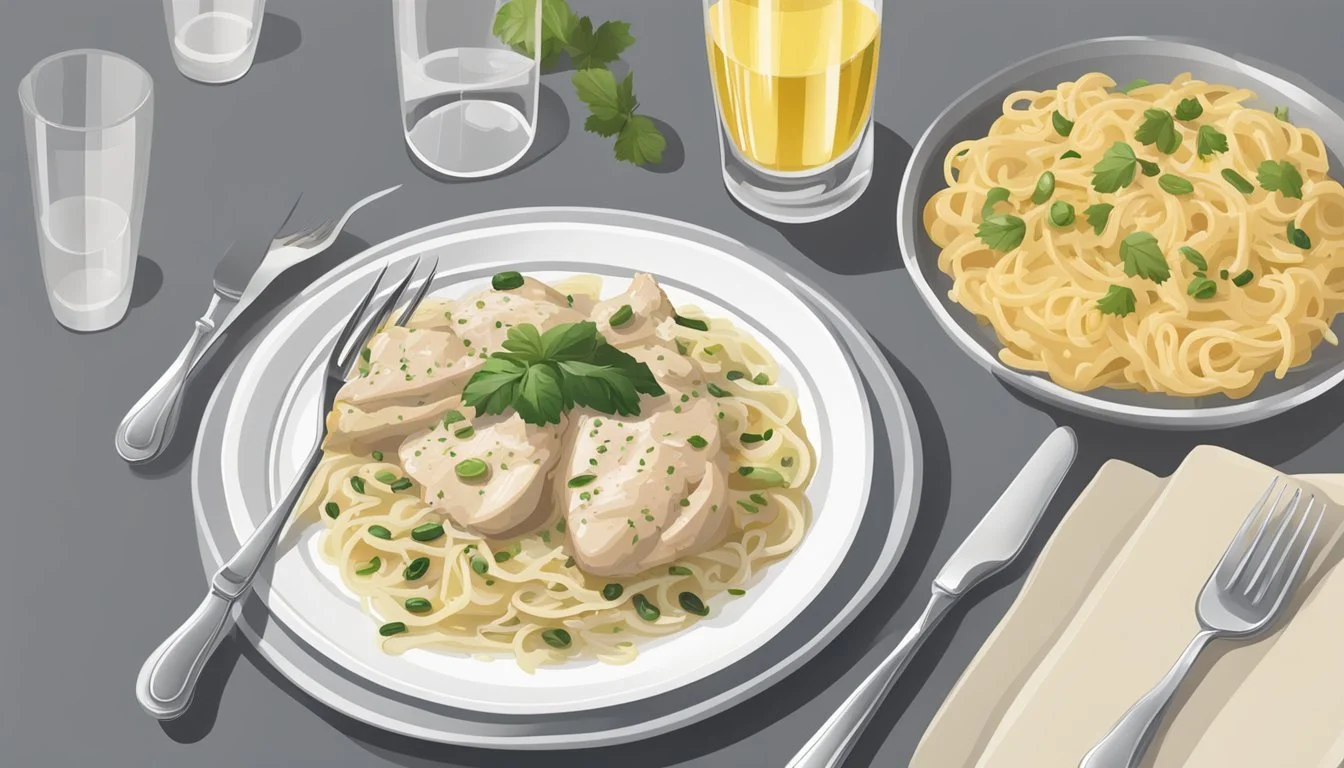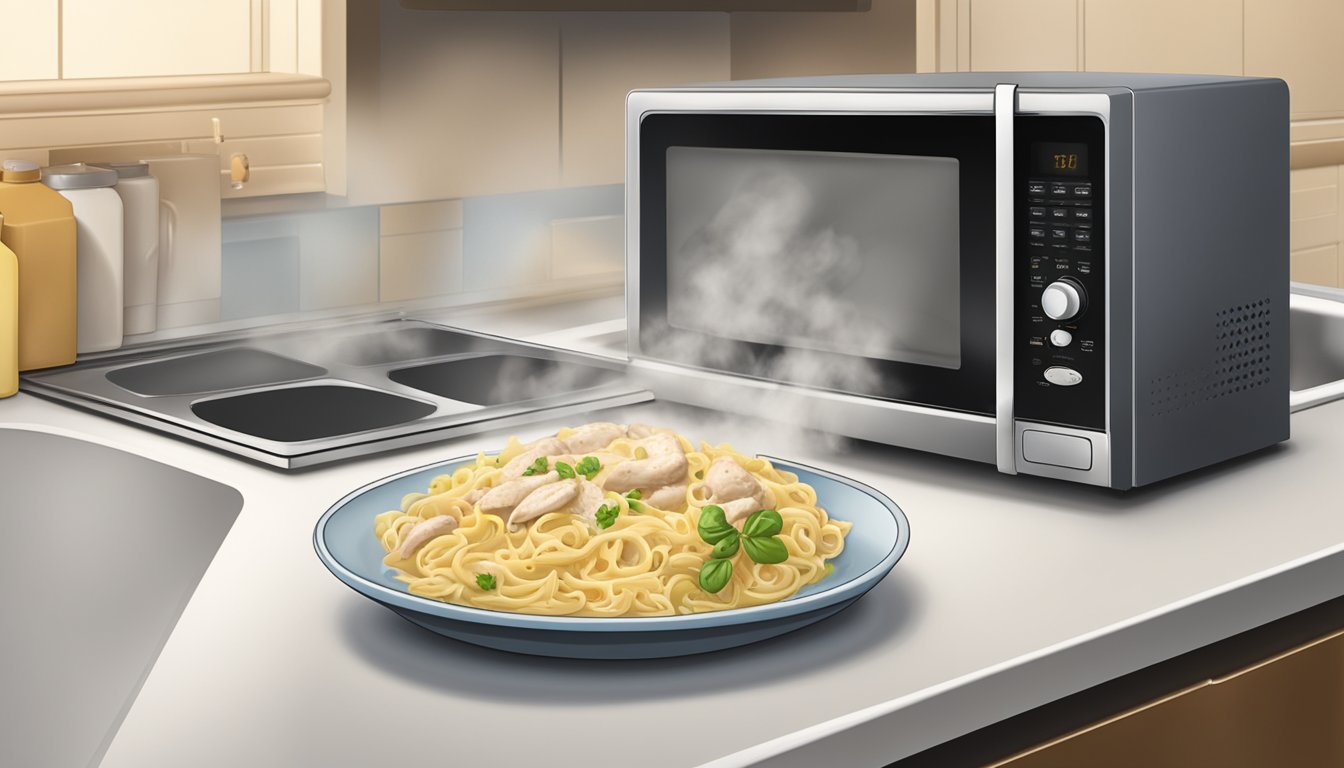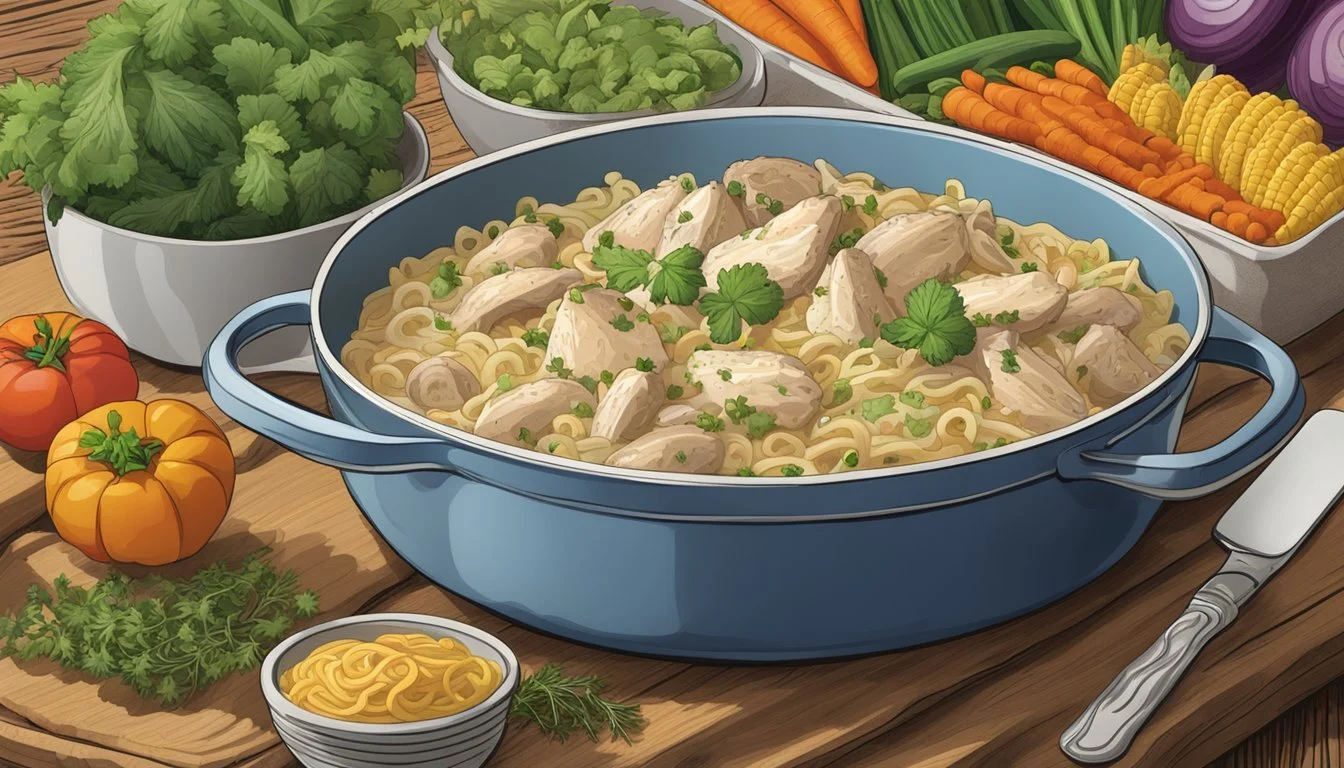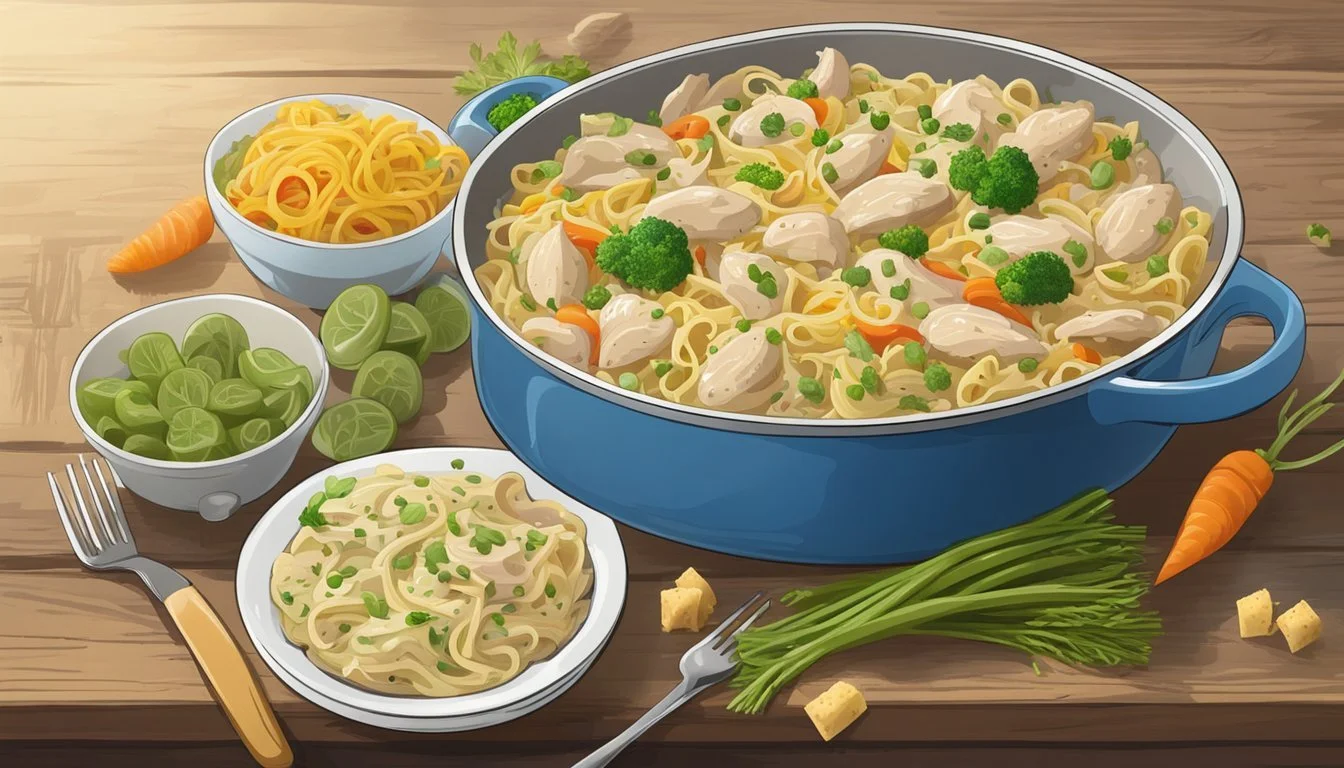Is Chicken Tetrazzini Gluten-Free?
Unveiling the Truth About This Classic Dish
Chicken Tetrazzini, a classic pasta (What wine goes well with pasta?) dish named after the Italian opera star Luisa Tetrazzini, traditionally consists of a creamy sauce, mushrooms, chicken, cheese, and spaghetti. It's a comfort food favorite in many households, known for its rich flavors and satisfying textures. However, for individuals with celiac disease or gluten sensitivity, the question of whether Chicken Tetrazzini can fit into a gluten-free diet is a pertinent one, owing to the inclusion of ingredients like wheat-based pasta and flour-thickened sauces which contain gluten.
The adaptation of this dish for a gluten-free diet isn't only possible, it's becoming increasingly common. Gluten-free Chicken Tetrazzini recipes use alternatives such as gluten-free pasta, which can be made from brown rice, quinoa, or corn. Thickeners for the sauce such as tapioca starch or a gluten-free all-purpose flour blend can replace traditional wheat flour, and careful selection of additional ingredients, such as broth and cream cheese, ensures that they too are gluten-free.
It's important for those requiring a gluten-free diet to scrutinize every ingredient in Chicken Tetrazzini. Cross-contamination is also a factor to consider, especially when dining out or purchasing pre-made versions of the dish. However, with the growing availability of gluten-free options, Chicken Tetrazzini can remain on the menu for those avoiding gluten, provided the necessary modifications are made.
Understanding Gluten-free Diets
In a gluten-free diet, careful attention is given to eliminate all forms of gluten, which is a protein complex found in certain grains. This diet is essential for individuals with celiac disease or gluten intolerance, as it aids in preventing adverse health effects and promoting well-being.
What Includes Gluten?
Gluten is primarily found in grains such as:
Wheat
Barley
Rye
These grains are common ingredients in:
Breads
Pastas
Cereals
Baked goods
Oats can also be a concern due to cross-contamination, unless they are specifically labeled as gluten-free.
Health Benefits of Gluten-free Eating
For individuals with celiac disease or gluten intolerance, adhering to a gluten-free diet is beneficial as it:
Alleviates symptoms like bloating, gas, and diarrhea.
Prevents damage to the small intestine.
Reduces the risk of associated disorders such as certain types of dermatitis and anemia.
For the general population without these conditions, the health benefits of a gluten-free diet are not conclusive.
Celiac Disease and Gluten Intolerance
Celiac disease is an autoimmune disorder where ingestion of gluten leads to damage in the small intestine. On the other hand, gluten intolerance, also known as non-celiac gluten sensitivity, causes discomfort without the intestinal damage.
Key differences include:
Celiac disease can be diagnosed with specific tests, whereas gluten intolerance is identified based on symptoms after ruling out other conditions.
Symptoms for both can include gastrointestinal distress, fatigue, and joint pain, but celiac disease may also lead to malnutrition and weight loss.
Avoiding gluten is critical for individuals with these conditions to maintain their health.
Chicken Tetrazzini Essentials
In exploring the essentials of Chicken Tetrazzini, one must understand the dish's core makeup and the traditional ingredients that comprise its classic form. This section will focus on what Chicken Tetrazzini is and the ingredients typically used to create this comforting pasta dish.
What Is Chicken Tetrazzini?
Chicken Tetrazzini is a baked pasta dish featuring chicken, mushrooms, and a rich cream sauce. It is typically made with spaghetti and baked until bubbly and golden on top. A distinguishing feature of this dish is the creamy texture and the savory flavor that is often accentuated by cheese and a buttery breadcrumb topping.
Traditional Ingredients
The traditional ingredients of Chicken Tetrazzini are pivotal in achieving its characteristic flavor and texture. Here is a breakdown of these components:
Pasta: Spaghetti is the standard choice, serving as the base of the dish.
Protein: Chicken, usually cooked and then shredded or chopped, is the star protein.
Vegetables: Mushrooms are a key ingredient, providing earthiness and texture.
Dairy: A combination of milk or cream, along with butter and cheese (like Parmesan), creates a rich and indulgent sauce.
Thickener: Flour is commonly used to thicken the sauce, binding the ingredients together.
For those requiring a gluten-free version of Chicken Tetrazzini, substitutions such as gluten-free flour blends for thickening, gluten-free pasta in place of traditional spaghetti, and ensuring all dairy and broth ingredients are gluten-free will be necessary.
Gluten-free Alternatives
When preparing chicken tetrazzini, selecting gluten-free alternatives for pasta and thickeners is essential for those with celiac disease or gluten sensitivities. Ensuring these substitutes are not only free from gluten but also capable of mimicking the traditional texture and taste of the dish is a key consideration.
Choosing Gluten-free Pasta
Gluten-free pasta options are plentiful and can be made from various grains and legumes such as rice, corn, quinoa, and chickpeas.
Brown rice pasta: Offers a whole grain alternative that is firm in texture and neutral in flavor.
Quinoa pasta: High in protein and with a nuttier taste, it holds up well in casseroles (What wine goes well with casseroles?).
Corn pasta: Provides a similar color to traditional wheat pasta, with a slightly sweet taste.
When selecting gluten-free pasta, one should always check the packaging to confirm that it has been produced in a gluten-free facility to prevent cross-contamination.
Gluten-free Sauces and Thickeners
For sauces and even to create a roux, a variety of gluten-free flours and starches can be used.
Gluten-free all-purpose flour: Easily substituted on a one-to-one basis for regular flour to thicken sauces.
Tapioca starch: A fine powder that thickens without adding a discernible flavor or heaviness to the dish.
Gluten-free bread crumbs: Can make a crispy topping for tetrazzini.
Almond meal: Works as a base for a roux or as a crumbly topping, adding a subtle nuttiness to the dish.
To ensure a creamy consistency, these thickeners should be mixed with cool liquids before adding to the sauce to avoid lumps. Gluten-free products should be clearly labeled and brands should be researched to ensure there is no risk of cross-contamination.
Preparing Gluten-free Chicken Tetrazzini
Crafting a savory and satisfying gluten-free Chicken Tetrazzini requires careful selection of suitable ingredients and the application of specific cooking techniques. The dish is not only wholesome but also ensures a delightful culinary experience for those with gluten sensitivities.
Selecting Your Ingredients
Pasta: Choose certified gluten-free spaghetti or noodles, ensuring they are made from non-gluten-containing grains like rice or corn.
Chicken: Opt for cooked and shredded or bite-sized chicken pieces, which can be prepared in advance or sourced from a gluten-free rotisserie chicken.
Cheese: Freshly grated Parmesan cheese is essential for a rich flavor—ensure it's natural and without added fillers that might contain gluten.
Sauces and Thickeners: For the creaminess typical of tetrazzini, utilize gluten-free Alfredo sauce or a homemade bechamel using gluten-free flour, like tapioca starch or cornstarch.
Vegetables and Herbs: Fresh mushrooms, onions, and parsley enhance the dish with umami and freshness, respectively.
Cooking Fats: Use butter or gluten-free nonstick spray for sautéing and greasing the baking dish.
List of Basic Gluten-free Ingredients:
Gluten-free spaghetti
Cooked chicken
Freshly grated Parmesan cheese
Gluten-free Alfredo sauce or homemade béchamel with gluten-free flour
Fresh mushrooms, onions, and parsley
Butter or gluten-free nonstick spray
Salt and pepper for seasoning
Gluten-free Cooking Techniques
Pasta Preparation: Boil the gluten-free spaghetti to an al dente texture, slightly firmer than usual, as it will continue to cook in the oven.
Bechamel Sauce: If making a roux-based sauce, blend gluten-free flour into the sautéed vegetables before slowly adding liquid to avoid lumps.
Assembling: In a casserole dish, combine the al dente spaghetti, chicken, and sauce. Integrate the components thoroughly for even distribution of flavors.
Baking: Preheat the oven to the required temperature—typically around 350°F to 375°F. Sprinkle the mixed ingredients with Parmesan cheese and bake until the cheese is melted and the top is golden-brown.
Cooking Tip: Always use clean utensils to prevent cross-contamination with gluten-containing foods.
By attentively selecting gluten-free ingredients and employing the right cooking methods, one can easily prepare a Chicken Tetrazzini that not only complies with dietary restrictions but also promises to be a crowd-pleaser.
Nutritional Insights
When considering Chicken Tetrazzini, particularly its gluten-free version, it's essential to examine its nutritional profile, focusing on caloric content and macronutrient breakdown, to understand its potential impact on dietary intake.
Caloric Content
Chicken Tetrazzini's caloric value can vary based on ingredients and portion sizes. A standard serving size generally contains approximately 350 to 450 calories. The use of gluten-free pasta, lean chicken, and a moderate amount of cheese can influence the total caloric content, making it suitable for those monitoring their energy intake.
Macronutrient Breakdown
The nutritional makeup of Chicken Tetrazzini includes a balance of macronutrients. Here is a typical breakdown for a standard serving:
Total Fat: 10-20 grams
Including Saturated Fat: 3-6 grams
Cholesterol: 30-80 milligrams
Sodium: 400-700 milligrams
Total Carbohydrate: 30-50 grams
Dietary Fiber: 2-4 grams
Sugars: 3-5 grams
Protein: 25-35 grams
Each serving can provide nutritional benefits when chosen mindfully. Chicken is an excellent source of lean protein while the dish can be customized with an array of vegetables that add fiber and micronutrients like Vitamin C and Calcium. However, one should be mindful of fat, particularly saturated fat, and sodium levels to align with balanced eating guidelines.
Recipe Variations and Tips
Crafting a delicious Chicken Tetrazzini that caters to specific dietary requirements or preferences is achievable with a variety of substitutions and alternatives. By paying attention to ingredient choices, chefs can confidently create versions that are gluten-free, dairy-free, vegetarian, or suited to utilizing different protein sources.
Dairy-free and Vegetarian Options
For a dairy-free version of Chicken Tetrazzini, one can replace butter with plant-based margarine and swap traditional cream or cheese with dairy-free alternatives. Popular dairy-free cheese options include:
Mozzarella: Look for a plant-based mozzarella that melts well.
Cheddar: Dairy-free cheddar can add a sharper taste.
Parmesan: Nutritional yeast flakes or vegan parmesan substitutes provide a similar umami flavor.
To make the dish vegetarian, one can remove the chicken altogether and instead increase the portion of mushrooms or add other vegetables like zucchini or spinach for a hearty fill. For another layer of texture, tofu or a plant-based meat substitute is an excellent addition.
Meat Alternatives
Chicken Tetrazzini traditionally features chicken as its primary protein, but there are various other meats that can be used:
Leftover chicken or rotisserie chicken: These are convenient and time-saving options.
Turkey: One can easily turn this into Turkey Tetrazzini, especially as a delicious way to use up holiday leftovers.
Ingredient Notes and Substitutes
Replacing traditional pasta with gluten-free noodles is key in making Chicken Tetrazzini gluten-free. One should ensure that all other ingredients, such as broth and soups, are also certified gluten-free to prevent cross-contamination.
Thickener: Instead of wheat flour, use alternatives like cornstarch or tapioca starch to thicken the sauce.
Alfredo sauce: Choose a gluten-free brand, or make a homemade version using gluten-free ingredients.
Remember to always read labels carefully to verify that each ingredient meets the necessary dietary requirements.
Serving and Pairing
When serving Chicken Tetrazzini, the focus should be on complementing the creamy, savory flavors and providing balance with light side dishes and appropriate beverages.
Recommended Side Dishes
For a well-rounded meal, side dishes should be chosen to contrast the rich texture of Chicken Tetrazzini. They include:
Vegetables: Steamed or roasted vegetables such as broccoli, asparagus, or a mixed vegetable medley can provide a refreshing crunch and nutritional balance.
Salads: A fresh green salad with a light vinaigrette dressing can counterbalance the creaminess of the tetrazzini.
Accompanying Beverages
The choice of beverage can enhance the dining experience:
White Wine: A crisp Chardonnay or a light Pinot Grigio pairs well by cutting through the richness of the dish.
Red Wine: For those who prefer red, a light-bodied Pinot Noir can complement the flavor profile without overwhelming the chicken tetrazzini.
Non-Alcoholic Options: Iced tea or sparkling water with a wedge of lemon can offer a refreshing taste to cleanse the palate.
Storing and Reheating
Storing and reheating Chicken Tetrazzini requires attention to detail to maintain its quality. The guidelines below ensure that leftovers remain delicious and safe for consumption.
Proper Storage Methods
For storing Chicken Tetrazzini:
Refrigeration: Place leftovers in an airtight container to keep them fresh. Refrigerate promptly after the meal, preferably within two hours of cooking.
Freezing: To extend the shelf life, Chicken Tetrazzini can be frozen. Use a freeze-safe container, label with the current date, and consume within three months.
Reheating without Compromising Quality
When reheating Chicken Tetrazzini:
Oven Method: Preheat the oven to 350°F, transfer the Tetrazzini to an oven-safe dish, and cover with foil to prevent drying. Heat until the internal temperature reaches 165°F.
Microwave Method: For single servings, use a microwave-safe dish. Reheat on 50% power to heat thoroughly without compromising the sauce's creamy texture. Check that it's evenly heated before consuming.
Creating the Complete Experience
Crafting a gluten-free Chicken Tetrazzini involves particular steps to ensure a delectable casserole while monitoring prep and cook times for efficiency. A chef looks to transform this comfort food into an inviting pasta bake that caters to dietary restrictions without compromising on flavor or texture. Presentation, too, becomes key in elevating the dish from a mere meal to a complete experience, inviting a garnish of fresh parsley for a final touch.
Step-by-Step Cooking Guide
Prep Time: It's important to allocate sufficient prep time, roughly 20 minutes, to organize ingredients and preheat the oven to 350°F (175°C).
Cooking the Pasta: Choose a gluten-free pasta option and boil until al dente, as per package instructions; then rinse under cold water.
Preparing the Sauce: Sauté mushrooms until soft, then blend in a gluten-free thickener like tapioca starch to prevent lumps. Proceed to add the liquid ingredients and cheese, stirring to create a smooth sauce.
Assembling the Casserole: In a sizeable greased baking dish, mix the cooked pasta, shredded chicken, the sauce, and additional vegetables evenly.
Cook Time: Insert the assembled casserole into the oven, baking for 25-30 minutes or until the cheese is melted and bubbling.
Total Time: Anticipate that the entire process should take approximately 1 hour from start to finish, with the cook time being a significant component.
Presentation Tips
Dish Selection: Presenting the Chicken Tetrazzini in an elegant, oven-to-table casserole dish emphasizes the homely aspect of this comfort food.
Garnishing: Before serving, a sprinkle of fresh parsley can add a pop of color and aroma that complements the creamy texture, enhancing the visual appeal.
Serving Temperature: Serve the dish warm to highlight the creaminess of the cheese and the tender, gluten-free pasta at its optimal texture.
History and Origin of Chicken Tetrazzini
Chicken Tetrazzini is a dish whose origins intertwine with the culinary innovation of the early 20th century and the fame of an Italian opera singer. It is a dish marked by its creamy sauce and use of spaghetti, a nod to Italian-American cuisine.
The Creation and Spread of the Dish
The dish known as Chicken Tetrazzini was conceived in the early 1900s, with several stories attributing its invention to different chefs and locations. The essence of Chicken Tetrazzini lies in its creamy sauce, typically made with butter, cream or milk, and cheese, often flavored with sherry or white wine. It involves a mix of ingredients including diced chicken, mushrooms, and pasta, which is frequently spaghetti.
One account suggests that the famed chef Auguste Escoffier, who had a history of creating dishes inspired by notable individuals, may have had a role in the creation of this dish. The narrative indicates that it was in a time when chefs would often honor celebrities and notable figures through their culinary creations.
Luisa Tetrazzini: The Inspiration
The dish is named after Luisa Tetrazzini, an Italian opera singer who gained immense popularity in the early 20th century. Her influence extended beyond the stage, capturing the hearts of culinary experts who sought to commemorate her stardom through the eponymous dish. Luisa Tetrazzini represented a connection between the glamour of opera and the creativity of gastronomy, embodying the spirit of Italian flair paired with American abundance.
Whether the dish was first served in London or New York remains a topic of culinary debate. However, it is clear that Luisa Tetrazzini's legacy and the transatlantic exchange of culture played pivotal roles in the creation of this beloved classic.
Allergen and Dietary Consideration
When considering a dish like Chicken Tetrazzini, individuals with gluten intolerance or celiac disease must pay particular attention to ingredients and preparation to ensure the dish is truly gluten-free. Vigilance against allergens like gluten is critical in such dietary considerations.
Cross-Contamination Risks
Cross-contamination is a major concern for those with celiac disease or gluten sensitivity. It occurs when gluten-free foods come into contact with gluten-containing foods or surfaces. For individuals preparing Chicken Tetrazzini at home, it's crucial to use separate utensils, cookware, and surfaces for gluten-free cooking. Restaurants offering gluten-free options should have strict protocols to prevent cross-contamination, such as designated areas and appliances for gluten-free meal preparation.
Understanding Labels and Certifications
Reading labels and understanding certifications is essential for avoiding gluten exposure. Products used in gluten-free Chicken Tetrazzini, such as pasta and sauce, should be certified gluten-free by a third-party organization to ensure safety. Labels might indicate the absence of gluten, but certifications provide an extra layer of assurance that the product meets strict gluten-free standards. In the US, reputable certifications include:
Certified Gluten-Free by the Gluten Intolerance Group's Gluten-Free Certification Organization (GFCO)
Gluten-Free Certification Program (GFCP) backed by the National Celiac Association
NSF Certified Gluten-Free by NSF International
The presence of these certifications can help consumers make informed choices about the safety of the ingredients they are incorporating into their Chicken Tetrazzini.
Make-Ahead and Meal Prepping
Chicken Tetrazzini is an excellent dish for preparing in advance, making mealtime effortless. With the right steps, one can ensure they have a gluten-free meal that's ready when needed, simplifying their weeknight dinners or lunch preparations.
Preparing in Advance
One can prepare Chicken Tetrazzini up to 24 hours in advance and store it refrigerated. To do so, they should follow these steps:
Cook the pasta just short of al dente to prevent it from becoming too soft when reheated.
Mix together the cooked pasta, sautéed mushrooms, shredded chicken, and sauce. Use a gluten-free thickener such as cornstarch or tapioca starch if thickening is required.
Assemble the dish in a baking dish but hold off on adding any cheese topping until right before baking to maintain texture.
Cover the assembled dish with plastic wrap or aluminum foil and refrigerate.
When ready to serve, add the cheese topping and bake according to the recipe's instructions, allowing a few extra minutes since the dish will be cold from the refrigerator.
Freezer-friendly Tetrazzini
For those looking to stock up for the future, Chicken Tetrazzini freezes well and can provide a convenient and comforting meal.
How to Freeze:
Assemble the Tetrazzini without baking it; layer the precooked ingredients in a freezer-safe dish.
Cover the dish with a layer of plastic wrap and then aluminum foil to protect against freezer burn.
Label the container with the date and cooking instructions for future reference.
It can be stored in the freezer for up to 3 months.
Thaw in the refrigerator overnight before baking for the best results.
If baking from frozen, one should cover the dish with foil and bake at 375°F. They'll need to increase the cooking time by approximately 1 hour or until the Tetrazzini is thoroughly heated through.
Remove the foil for the last 10-15 minutes to allow the cheese to brown.
Answers to Common Questions
This section aims to address frequent inquiries pertaining to Chicken Tetrazzini's relationship with gluten, providing clarity on gluten-free preparations of this dish.
FAQs on Chicken Tetrazzini and Gluten
Is traditional Chicken Tetrazzini gluten-free?
Traditional Chicken Tetrazzini typically contains pasta and flour, ingredients that are sources of gluten. Therefore, the classic recipe is not gluten-free.
How can Chicken Tetrazzini be made gluten-free?
To prepare a gluten-free version of Chicken Tetrazzini, one must substitute regular pasta with a gluten-free alternative, such as Tinkyada or Barilla Gluten-Free pasta, and use a gluten-free thickener instead of regular flour.
What ingredients should I be cautious of when preparing gluten-free Chicken Tetrazzini?
When seeking to make Chicken Tetrazzini gluten-free, scrutinize labels on all pre-made components like broths, seasonings, and sauces, ensuring they do not contain gluten or have been cross-contaminated.
Ingredient Notes for Gluten-Free Chicken Tetrazzini:
Pasta: Choose reputable gluten-free pasta brands like Tinkyada or Barilla Gluten-Free that offer a texture similar to traditional pasta.
Thickeners: Utilize gluten-free thickeners such as cornstarch or tapioca starch for the sauce.
Seasonings: Confirm the gluten-free status of any pre-packaged seasonings or make your own blend.
Alfredo Sauce: If using a store-bought sauce, check for a gluten-free label to avoid hidden sources of gluten.
In summary, careful selection of ingredients is crucial in ensuring Chicken Tetrazzini is safe for those with gluten sensitivities or celiac disease. Gluten-free pasta options from brands like Tinkyada and Barilla, as well as proper attention to detail with thickeners and additives, can result in a delicious, gluten-free rendition of this classic dish.
Final Thoughts
Chicken Tetrazzini typically includes pasta, a creamy sauce, and, of course, chicken. Traditional recipes are not gluten-free due to the use of regular pasta and flour-based roux in the sauce. However, for those with celiac disease or gluten sensitivity, the dish can easily be adapted using gluten-free alternatives.
For pasta, there are numerous gluten-free options available, such as those made from rice, corn, or quinoa. To thicken the sauce, alternatives like tapioca starch or a gluten-free flour blend can be employed. It is vital for individuals managing gluten-free diets to carefully read labels, as gluten can lurk in unexpected ingredients like seasonings or pre-made sauces.
In preparing the dish, cooks should also be aware of cross-contamination. This refers to the inadvertent introduction of gluten into a gluten-free product. It's a common occurrence that can happen when sharing utensils between gluten-free and gluten-containing foods. Using separate cookware or ensuring thorough cleansing between uses can mitigate this risk.
Adapting Chicken Tetrazzini for a gluten-free diet does not compromise taste or texture when done properly. Enthusiasts can enjoy a fully flavorful and reminiscent version of the classic, ensuring that dietary restrictions do not limit the enjoyment of traditional comfort foods.

